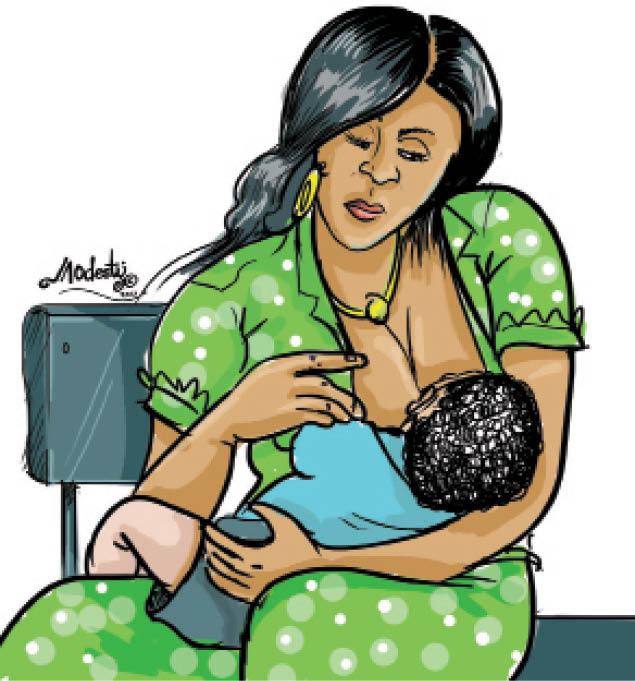I am a lactating mother diagnosed of Mastitis
Permit me a space in your esteemed weekly health column to ask about mastitis during lactation. I am a new mother with a two-week-old baby and my breast has swollen with some pains. I was told it is mastitis. I need simple information to understand the problem. Isher C. Thanks, Isher for your question. […]

Permit me a space in your esteemed weekly health column to ask about mastitis during lactation. I am a new mother with a two-week-old baby and my breast has swollen with some pains. I was told it is mastitis. I need simple information to understand the problem.
Isher C.
Thanks, Isher for your question. Mastitis simply means inflammation of the breast. One doesn’t have to be breastfeeding to get it, though in most cases, that’s the case. It can also come with infection or not. Either way, the breast is red, swollen and sore.
What are the causes of mastitis?
During breastfeeding, there are two primary mastitis causes:
-A clogged milk duct: When milk isn’t removed frequently or efficiently enough from the breast, the channel through which milk flows becomes so overwhelmed that milk builds up and is unable to flow out of the breast, resulting in what feels like tender lumps,
-Infection: Mastitis can also occur when bacteria creeps into the milk duct. A crack on the nipple from a poor latch or poor pumping can allow them to get inside the breast and create infection. Examples of common bacteria are Staphylococcus aureus and Staphylococcus albus,
What are the risks for mastitis?
• Age. Women who are 21 to 35 years old are more prone to mastitis, with the highest risk being women aged 30 to 34.
• History. Studies have shown 40 to 54 percent of women who previously had mastitis are more likely to suffer another attack. Experts think this could be the result of improper breastfeeding.
• Work. If you’re employed full-time outside your home, your chances for mastitis may increase. That’s because longer intervals in between pumping, as well as not enough time to void the breast completely of milk, can lead to milk stasis.
• Trauma. Any injury caused to the breast tissue that negatively affects glands and duct performance could increase a woman’s odds of mastitis.
What are the symptoms of Mastitis?
• Tender, swollen breasts
• The presence of one or more lumps in the breast
• Breasts that are warm or hot to the touch
• Breast pain or burning either during or while not breastfeeding
• Red skin, sometimes in a wedge-shaped pattern
• Flu-like symptoms, such as chills or fatigue
• Fever of 38.3℃ or above
What are the treatment options?
• If you notice nipple damage or painful lumps, seek help immediately. After all, when the inflammation in the breast isn’t treated, one can end up with an abscess, which typically requires surgical drainage.
• Drugs are prescribed in the short-term with an over-the-counter analgesic and also prescribed antibiotics
Some home remedies for Mastitis
• Nursing. As excruciating as it may be, breastfeeding through the pain is key to mastitis treatment. Baby’s suckling can help remove any clog while also draining the breast of residual milk.
• Moist heat. Before nursing, improve circulation to the breast area by using warm wet compresses or soaking in a warm bath or shower.
• Breastfeeding through the pain is not only an effective mastitis treatment, it also helps keep your milk supply up. Fortunately, in most cases, the milk is okay for baby to drink.
• Sore breast first. Baby is hungriest at the start of your nursing session, so always begin with the painful breast. Massage, pump or hand-express your breast first to help milk flow more easily for baby.
• Breastfeed often. Milk production is an ongoing process, so it needs to be removed to decrease the pressure on your breast. Aim to breastfeed every two hours or whenever baby is hungry,
• Change positions. Switch up your nursing position to help empty your breast completely of breast milk.
• Check your breasts. Always feel your breasts before and after nursing. The milk should be completely drained, and the breasts, softer or lighter afterward.
How to prevent Mastitis?
• Rest. Reduce stress and anxiety whenever possible, and get as much sleep as a newborn baby
• Drink. Staying hydrated with water will improve circulation while also helping to keep milk flowing.
• Nursing is a must! If the milk has somewhere to go, it won’t lead to a blockage or infection.
• Eat healthy. Boost your immune system with fresh food rich in vitamin C (citrus fruits), vitamin A (sweet potatoes, carrots)
• Wash up. Clean your hands with soap and water before and after breastfeeding, which can help to eliminate possible sources of bacteria.
